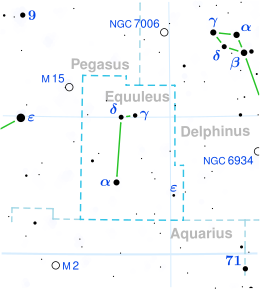HD 201507
| Observation data Epoch J2000.0 Equinox J2000.0 (ICRS) | |
|---|---|
| Constellation | Equuleus |
| Right ascension | 21h 09m 58.2645s[1] |
| Declination | +02° 56′ 37.3096″[1] |
| Apparent magnitude (V) | 6.43±0.01[2] |
| Characteristics | |
| Spectral type | F5 IV[3] |
| U−B color index | +0.06[4] |
| B−V color index | +0.37[4] |
| Astrometry | |
| Radial velocity (Rv) | −42.8±2.4[5] km/s |
| Proper motion (μ) | RA: +48.902 mas/yr[1] Dec.: +10.883 mas/yr[1] |
| Parallax (π) | 15.2530 ± 0.3122 mas[1] |
| Distance | 214 ± 4 ly (66 ± 1 pc) |
| Absolute magnitude (MV) | 2.12[6] |
| Details | |
| Mass | 1.45±0.23[7] M☉ |
| Radius | 2.2±0.1[7] R☉ |
| Luminosity | 9.147±0.21[1] L☉ |
| Surface gravity (log g) | 3.91±0.09[7] cgs |
| Temperature | 6,846±233[8] K |
| Metallicity [Fe/H] | +0.09[9] dex |
| Rotational velocity (v sin i) | 16.4±10.6[10] km/s |
| Age | 1.21[8] Gyr |
| Other designations | |
| Database references | |
| SIMBAD | data |
HD 201507, also designated HR 8095, is a white-hued star located in the equatorial constellation Equuleus. It has an apparent magnitude of 6.43,[2] placing it near the limit for naked eye visibility. Parallax measurements place the object at a distance of 214 light years[1] and it is currently drifting closer with a heliocentric radial velocity of −43 km/s.[5]
There have been disagreements in classifying the star's spectrum. Eugene A. Harlan found a spectral classification of F5 IV,[3] indicating that it is a F-type subgiant that is evolving towards the red giant branch. On the other hand, Nancy Houk and Carrie Swift (1999) found a class of F2 V,[13] indicating that it is still on the main sequence.
HD 201507 has 1.45 times the mass of the Sun and a slightly enlarged radius of 2.2 R☉[7] due to its evolved state. It shines with a luminosity of about 9 L☉[1] from its photosphere at an effective temperature of 6,846 K.[8] HD 201507 is slightly metal enriched, with a metallicity 123% that of the Sun.[9] This star has a modest projected rotational velocity of 16 km/s[10] and is estimated to be 1.21 billion years old,[8] only a quarter the age of the Sun.
References
[edit]- ^ a b c d e f g Brown, A. G. A.; et al. (Gaia collaboration) (August 2018). "Gaia Data Release 2: Summary of the contents and survey properties". Astronomy & Astrophysics. 616. A1. arXiv:1804.09365. Bibcode:2018A&A...616A...1G. doi:10.1051/0004-6361/201833051. Gaia DR2 record for this source at VizieR.
- ^ a b Høg, E.; Fabricius, C.; Makarov, V. V.; Urban, S.; Corbin, T.; Wycoff, G.; Bastian, U.; Schwekendiek, P.; Wicenec, A. (March 2000). "The Tycho-2 catalogue of the 2.5 million brightest stars". Astronomy and Astrophysics. 355: L27 – L30. Bibcode:2000A&A...355L..27H. ISSN 0004-6361.
- ^ a b Harlan, E. A. (June 1974). "MK classifications for F-and G-type stars. 3". The Astronomical Journal. 79: 682. Bibcode:1974AJ.....79..682H. doi:10.1086/111597. ISSN 0004-6256.
- ^ a b Cousins, A. W. J. (1971). "Photometric standard stars". Royal Observatory Annals. 7. Bibcode:1971ROAn....7.....C.
- ^ a b Gontcharov, G. A. (November 2006). "Pulkovo Compilation of Radial Velocities for 35 495 Hipparcos stars in a common system". Astronomy Letters. 32 (11): 759–771. arXiv:1606.08053. Bibcode:2006AstL...32..759G. doi:10.1134/S1063773706110065. eISSN 1562-6873. ISSN 1063-7737. S2CID 119231169.
- ^ Anderson, E.; Francis, Ch. (May 2012). "XHIP: An extended hipparcos compilation". Astronomy Letters. 38 (5): 331–346. arXiv:1108.4971. Bibcode:2012AstL...38..331A. doi:10.1134/S1063773712050015. eISSN 1562-6873. ISSN 1063-7737. S2CID 255204555.
- ^ a b c d Stassun, Keivan G.; et al. (9 September 2019). "The Revised TESS Input Catalog and Candidate Target List". The Astronomical Journal. 158 (4): 138. arXiv:1905.10694. Bibcode:2019AJ....158..138S. doi:10.3847/1538-3881/ab3467. ISSN 0004-6256.
- ^ a b c d David, Trevor J.; Hillenbrand, Lynne A. (12 May 2015). "The Ages of Early-type Stars: Strömgren Photometric Methods Calibrated, Validated, Tested, and Applied to Hosts and Prospective Hosts of Directly Imaged Exoplanets". The Astrophysical Journal. 804 (2): 146. arXiv:1501.03154. Bibcode:2015ApJ...804..146D. doi:10.1088/0004-637X/804/2/146. eISSN 1538-4357.
- ^ a b Netopil, Martin (4 May 2017). "Metallicity calibrations for dwarf stars and giants in the Geneva photometric system". Monthly Notices of the Royal Astronomical Society. 469 (3): 3042–3055. arXiv:1705.00883. Bibcode:2017MNRAS.469.3042N. doi:10.1093/mnras/stx1077. eISSN 1365-2966. ISSN 0035-8711.
- ^ a b De Medeiros, J. R.; Alves, S.; Udry, S.; Andersen, J.; Nordström, B.; Mayor, M. (January 2014). "A catalog of rotational and radial velocities for evolved stars: V. Southern stars⋆⋆⋆". Astronomy & Astrophysics. 561: A126. arXiv:1312.3474. Bibcode:2014A&A...561A.126D. doi:10.1051/0004-6361/201220762. ISSN 0004-6361.
- ^ Gould, B. A. Uranometria Argentina. Reprinted and updated by Pilcher, F. Archived from the original on 2012-02-27. Retrieved 2012-01-06.
- ^ "HD 201507". sim-id. Retrieved 2021-07-05.
- ^ Houk, Nancy; Swift, Carrie (1999). Michigan catalogue of two-dimensional spectral types for the HD Stars; vol. 5. Bibcode:1999mctd.book.....H.

